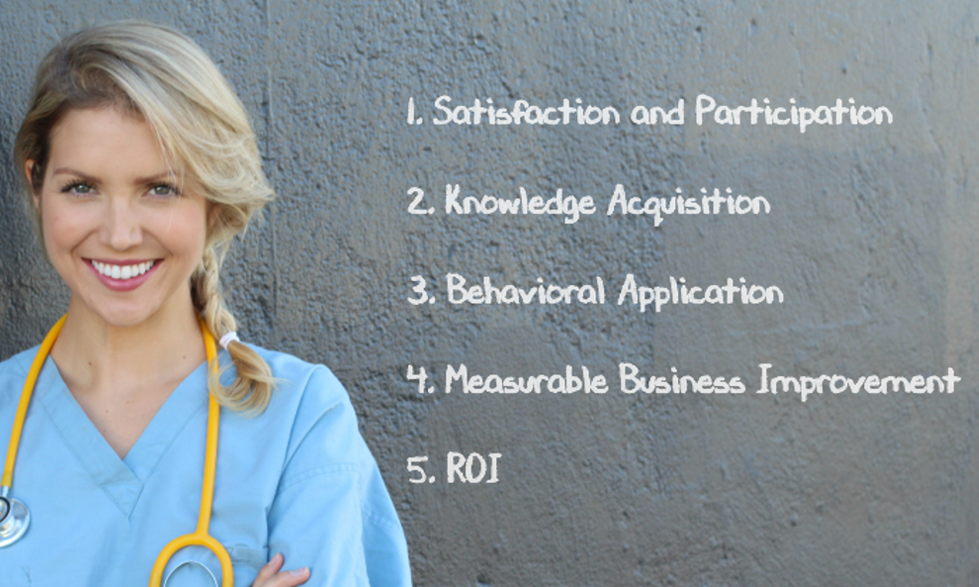Most great healthcare companies have well-financed programs to develop Directors and C-suite executives, but sometimes frontline nurse leaders are overlooked. When budgets are tight, you are often asked to do more with less. Showing ROI of nurse leadership development may sound complicated, but it’s important if you want to make training frontline nurse leaders a priority.
Start your ROI analysis by clearly defining your desired operational outcomes, then establish the right learning objectives, purchase the right content, and have a system set up for delivery and evaluation. Determining an accurate ROI is a process, but using a good external partner will help! Here is a brief summary of how to determine ROI of nurse leadership development:
1) Satisfaction and Participant Reaction:
These surveys are the most basic evaluation and are used to see how participants reacted to training. Questions could include: Did your staff think this was an appropriate use of their time? Is the material relevant to their work? Would they recommend this course to colleagues? While satisfaction and reaction may sound marginal, knowledge learning and application follow training satisfaction.
2) Knowledge Acquisition:
To evaluate knowledge acquired, first identify the “gap” between skills nurses actually have, and what they should have, to hit your organization’s learning objectives. This evaluation is often an examination to see if the appropriate training content was understood and acquired. It can also flag participants who did not make learning efforts, or support those who did, potentially making them mentors to others. Be sure to join forces with Human Resources and to integrate training goals with employee reviews.
Examples of Knowledge Acquisition to measure: After training, can nurses identify problems that call for intervention? Can nurse participants provide examples of how development assists in their role, or to help their team?
Participants take training more seriously when they know they will be requested to demonstrate what they learned later! So sending participants the exam within a week of training, grading them, and sharing with their managers will increase learning efficiency. Any gaps in knowledge can be attended to after that, with the managers or other nursing staff help.
3) Behavioral Application:
The 3rd level of evaluation answers the question ‘Are nurses applying what they learned?’ What behaviors are you seeking to change as the knowledge and skills are applied on the job following training? Use your nurse managers or directors for feedback. To take your ROI study to a higher level, compare the results to a control group of employees that didn’t receive training. Or if it is a small group, get 100% random sampling. Repeat the evaluation at appropriate times, including after a time lapse.
A best practice to increase behavioral application is to recruit a small training advisory team from the training participant cohort, and make it a team effort! Have small teams of peers who can cheerlead when they see behavior application from training in real-time. It will keep training relevant for longer time frames, until it becomes a part of business culture.
4) Measurable Business Improvement:
Business training is about generating a business improvement. What Key Performance Indicators do you want to change or improve as a result of training? Is it an increase in safety improvements? An increase in HCAHPS? A decrease in incidents? Higher retention or higher rates of continuing education? Or was there a quality improvement implemented as a result of the training? A best practice in finding measurable business improvement is to have nurse participants brainstorm and plan for a project during training, then have a 30 and 90 day posttraining check-in with their leaders to see effects of that project, and measure results.
5) Return on Investment (ROI):
The last evaluation method, this looks at justifiable savings or increased revenue. Measurement technique will greatly vary by organization, but generically it is course fee minus facility fee, add opportunity cost of nurse training hours, measure impact, then consider financial gains in the long run – then see long-term gains divided by cost = ROI.
Determining ROI of nurse leadership development is not easy. In evaluating learning at a high level, usually ROI follows business impact, business impact follows application, application follows learning, and learning follows satisfaction with training. Each step is important. For further information, The Kirkpatrick Model is a great reference for learning about evaluating the effectiveness of corporate development.
Having the right external partner to assist in measuring nurse leadership development, such as Catalyst Learning, can kick-start the process. External partners cannot be on-site to measure nurse behaviors. But partners can share best measurement practices, provide curriculum, delivery method, and tools and processes for collection of data, and other consulting support.
